Santiago, Chile - 19-January-2000
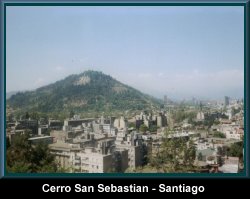 Well, well, well ... another place that I never thought I
would ever visit: Chile. Because I never thought I would travel
to Chile, I did what most Americans (well, lets be honest....what
most people do, American or not) do when considering other people
in the world: I ignored it. Perhaps that is a little harsh:
Instead, let's just say that I was indifferent to Chile, her
people, and her politics. Over the past few years, I have started
to learn what sheer folly this outlook on the world is. In this
day and age when a flight on the Concorde can get you from North
America to Europe in just a few short hours, and Boeing is
working on a 747 with the fuel capacity to make it from San
Francisco to Moscow,
Well, well, well ... another place that I never thought I
would ever visit: Chile. Because I never thought I would travel
to Chile, I did what most Americans (well, lets be honest....what
most people do, American or not) do when considering other people
in the world: I ignored it. Perhaps that is a little harsh:
Instead, let's just say that I was indifferent to Chile, her
people, and her politics. Over the past few years, I have started
to learn what sheer folly this outlook on the world is. In this
day and age when a flight on the Concorde can get you from North
America to Europe in just a few short hours, and Boeing is
working on a 747 with the fuel capacity to make it from San
Francisco to Moscow, 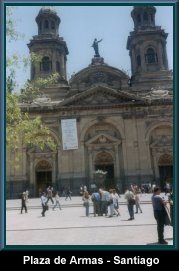 non-stop, it is foolish to ignore other
countries and cultures. Add to this the "coming of age"
of the World Wide Web, and it becomes even more important to know
more about your neighbors, because with the Net, everyone in the
world is your neighbor. With that being said, I encourage all of
you to ignore Chile...that way it will remain as beautiful as it
is today (and the next time I go back there won't be throngs of
tourists there who read this web page and decided to see it for
themselves).
non-stop, it is foolish to ignore other
countries and cultures. Add to this the "coming of age"
of the World Wide Web, and it becomes even more important to know
more about your neighbors, because with the Net, everyone in the
world is your neighbor. With that being said, I encourage all of
you to ignore Chile...that way it will remain as beautiful as it
is today (and the next time I go back there won't be throngs of
tourists there who read this web page and decided to see it for
themselves).
Santiago currently stands as my "furthest point
south" on the globe. The interesting thing is that Santiago
is situated just a little farther South of the Equator than
Sacramento (where I currently reside) lies North of the Equator.
This makes for a VERY long plane flight (something like 11 and 1/2
hours from Dallas, TX) from the US (don't be fooled into thinking
that South America is "right next door"...a flight from
Miami to the Northernmost city in South America is still a 3 and
1/2 hour plane ride) and Santiago is a LONG way south. Also of
interest is the fact that Santiago is climatically quite similar
to the Central Valley of California. Both are roughly 100 miles
inland from the coast. Both have relatively low coastal mountain
ranges, then a wide valley that rises to a much larger mountain
range in the East. There is even a cold ocean current that flows
down the Western Coast of South America, much like the one off
the coast of California. This creates similar weather patterns,
although they are during opposite seasons (Winter in Chile is
June, July and August). 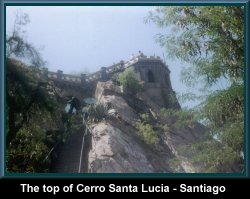 My trip to Santiago in February felt
exactly like late September in Sacramento: pleasantly warm with
low humidity. A lot of the flora and fauna are quite similar too,
although Santiago has some indigenous plants as well. Don't let
this "similarity" to Central Northern California fool
you, however. Chile is a country that stretches nearly 4,300
kilometers (2,700 miles for the "metrically-challenged")
and encompasses drastic differences in geography: From the Atacama
Desert (a desert that has NEVER recorded rainfall) that lies
in the northern part of the country, to the vast rainforests of Patagonia
to the frigid lands of Antarctica....Chile has it all.
My trip to Santiago in February felt
exactly like late September in Sacramento: pleasantly warm with
low humidity. A lot of the flora and fauna are quite similar too,
although Santiago has some indigenous plants as well. Don't let
this "similarity" to Central Northern California fool
you, however. Chile is a country that stretches nearly 4,300
kilometers (2,700 miles for the "metrically-challenged")
and encompasses drastic differences in geography: From the Atacama
Desert (a desert that has NEVER recorded rainfall) that lies
in the northern part of the country, to the vast rainforests of Patagonia
to the frigid lands of Antarctica....Chile has it all.
As usual, I
scheduled my flight to arrive early in the morning to allow
myself a day of sightseeing before going to work (unfortunately,
my company doesn't send me anywhere for just a vacation). I found
Santiago's airport to be medium sized and pleasant. Despite the
fact that I had obtained the necessary work Visa for Chile, I (and
all the other travelers) needed to pay an "admission fee"
to enter the country. $40 lighter in my wallet (the $40, by the
way, gains you unlimited entries into Chile for a year), I caught
a taxi to my Hotel in the Las Condes area 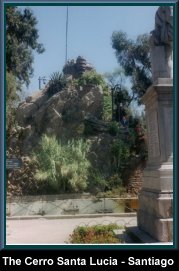 of Santiago on
the Eastern edge of town. There was a noticeable lack of "shanty
towns" which always seem to exist on the outskirts of major
South American cities, which testifies to the prosperity of the
Chileans. Indeed Chile is one of South America's most stable
countries, both politically (despite the Pinochet incident) and
economically. Comfortably ensconced in my hotel (the Regal
Pacific in Las Condes), I headed out to see the city.
Santiago actually has a useful (to us tourists) subway (Métro)
system. Other South American cities such as Caracas,
Venezuela and Sao
Paulo, Brazil have métros, but they don't really go
anywhere interesting...they are basically built for moving the
population to and from work. Santiago's métro took me
from my hotel in Las Condes into the center of the city.
The Estación Santa Lucia or the Estación Universidad
de Chile will deposit you exactly where you want to be to
see Santiago's sights.
of Santiago on
the Eastern edge of town. There was a noticeable lack of "shanty
towns" which always seem to exist on the outskirts of major
South American cities, which testifies to the prosperity of the
Chileans. Indeed Chile is one of South America's most stable
countries, both politically (despite the Pinochet incident) and
economically. Comfortably ensconced in my hotel (the Regal
Pacific in Las Condes), I headed out to see the city.
Santiago actually has a useful (to us tourists) subway (Métro)
system. Other South American cities such as Caracas,
Venezuela and Sao
Paulo, Brazil have métros, but they don't really go
anywhere interesting...they are basically built for moving the
population to and from work. Santiago's métro took me
from my hotel in Las Condes into the center of the city.
The Estación Santa Lucia or the Estación Universidad
de Chile will deposit you exactly where you want to be to
see Santiago's sights.
You start on Libertador Géneral
Bernardo O'Higgins (yes, that's a street...you can call it Alameda
for short....the locals do). Cross over to the North side of
"the Alameda" and head East toward the Andes
Mountains. Take a left on 21 de Mayo (I'll never understand the
South American obsession with naming streets after dates....there's
a major avenue in Sao Paulo, Brazil named after a date in April)
and keep going until you hit the Plaza de Armas. Check
out the original post office, the Correo Centro (rumor
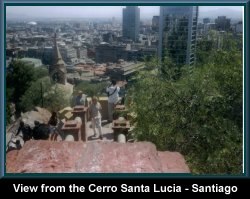 has it that all points in Chile are measured in kilometers from
this office. Kinda like Rome, isn't it?), the Catedral (no, that's
not a spelling mistake), the Palacio de la Real Audencia (Natural
History Museum), and enjoy a rousing game of chess and a lemonade
in the square (just watch out for the "dive bomber"
pigeons in the square). Head east out of Plaza de Armas
on Merced. On the corner of Merced and Mac-Iver
(a few blocks ) is the Basilica Merced a "church-turned-museum".
Unfortunately, this was closed the day I was there. According to
my guidebook (the "Open Road" Chile Guide), this place
has some of the best artifacts from Easter Island (owned by Chile).
There are several other museums in this area that deal with
colonial Chile and one in particular that my guidebook rather
colorfully referred to as "...and extensive tribute to
dandified white guys with guns..." (sorry, I just
couldn't resist putting that line up here on my page....it kills
me!). I stopped for lunch at a French place on Merced called 'Les
Assesins'. The Coquille San Jacques was fantastic,
and best of all, they understood my French (my Spanish is merely
passable). Wash your meal down with the Chilean "Pisco
Sour". Pisco is a type of brandy (this
originally comes from Peru, but don't tell that to the Chileans).
Mixed with lemon juice, powdered sugar and egg whites, it creates
the wonderfully refreshing Pisco Sour (don't have too
many, though...this ranks right up there with the Brazilian Caipirihnia
for "most punch per drink").
has it that all points in Chile are measured in kilometers from
this office. Kinda like Rome, isn't it?), the Catedral (no, that's
not a spelling mistake), the Palacio de la Real Audencia (Natural
History Museum), and enjoy a rousing game of chess and a lemonade
in the square (just watch out for the "dive bomber"
pigeons in the square). Head east out of Plaza de Armas
on Merced. On the corner of Merced and Mac-Iver
(a few blocks ) is the Basilica Merced a "church-turned-museum".
Unfortunately, this was closed the day I was there. According to
my guidebook (the "Open Road" Chile Guide), this place
has some of the best artifacts from Easter Island (owned by Chile).
There are several other museums in this area that deal with
colonial Chile and one in particular that my guidebook rather
colorfully referred to as "...and extensive tribute to
dandified white guys with guns..." (sorry, I just
couldn't resist putting that line up here on my page....it kills
me!). I stopped for lunch at a French place on Merced called 'Les
Assesins'. The Coquille San Jacques was fantastic,
and best of all, they understood my French (my Spanish is merely
passable). Wash your meal down with the Chilean "Pisco
Sour". Pisco is a type of brandy (this
originally comes from Peru, but don't tell that to the Chileans).
Mixed with lemon juice, powdered sugar and egg whites, it creates
the wonderfully refreshing Pisco Sour (don't have too
many, though...this ranks right up there with the Brazilian Caipirihnia
for "most punch per drink").
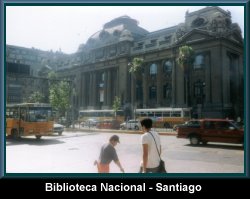 Continue heading East (as a
side note, there is a lot of Art Deco and Neoclassical
Architecture in this neighborhood....be sure to check it out)
until you reach the Cerro Santa Lucia. You can't miss
this thing...it's a huge mountain right in the middle of the city.
When entering, you will be asked to "sign in" with your
passport (apparently, there once was a lot of crime in this park,
and the City is doing this as a protective measure. I found it to
be quite safe during the day, but I wouldn't want to try this
place at night). This was my favorite place in all of Santiago.
At the top of the hill, there is a replica of a Medieval Castle,
and there are all sorts of plants, flowers, statues and fountains
all over this mountain and it provides fantastic views of the
city and the Andes. If you are fortunate enough to be travelling
with your "significant other", find a small secluded
place in the rocks and "make out" like crazy....it's
what the locals do. From the top of the mountain, you can also
see a neighboring hill called the Cerro San Cristobal
and the cable car that takes you to the top. On one side of the
mountain, you will see the Biblioteca Nacional. Head to
the right of this, and exit through the main entrance/exit to the
Cerro Santa Lucia and cross the Alameda (good
luck...there is an iron fence in the median and no crosswalks for
about a mile or so on either side. Go ahead....live dangerously)
to the Centro Artesanal de Santa Lucia. This place is
one of the best markets that I have seen. Pick up some Lapis
Lazuli jewelry or some Chilean CDs or (if you're loaded
with Chilean Pesos) splurge on some fantastic artwork.
Continue heading East (as a
side note, there is a lot of Art Deco and Neoclassical
Architecture in this neighborhood....be sure to check it out)
until you reach the Cerro Santa Lucia. You can't miss
this thing...it's a huge mountain right in the middle of the city.
When entering, you will be asked to "sign in" with your
passport (apparently, there once was a lot of crime in this park,
and the City is doing this as a protective measure. I found it to
be quite safe during the day, but I wouldn't want to try this
place at night). This was my favorite place in all of Santiago.
At the top of the hill, there is a replica of a Medieval Castle,
and there are all sorts of plants, flowers, statues and fountains
all over this mountain and it provides fantastic views of the
city and the Andes. If you are fortunate enough to be travelling
with your "significant other", find a small secluded
place in the rocks and "make out" like crazy....it's
what the locals do. From the top of the mountain, you can also
see a neighboring hill called the Cerro San Cristobal
and the cable car that takes you to the top. On one side of the
mountain, you will see the Biblioteca Nacional. Head to
the right of this, and exit through the main entrance/exit to the
Cerro Santa Lucia and cross the Alameda (good
luck...there is an iron fence in the median and no crosswalks for
about a mile or so on either side. Go ahead....live dangerously)
to the Centro Artesanal de Santa Lucia. This place is
one of the best markets that I have seen. Pick up some Lapis
Lazuli jewelry or some Chilean CDs or (if you're loaded
with Chilean Pesos) splurge on some fantastic artwork.
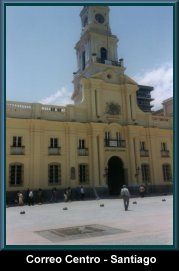 I had the eerie sensation of witnessing a full lunar eclipse while I was in
Santiago. This was a little creepy. First of all, I was on the 11th
floor of the hotel. With the Andes as a spectacular backdrop, I
watched while the moon slowly disappeared from view over several
hours. One tip if staying at the Regal Pacific: try to get a room
on one of the upper floors with a North facing view. I was very
eager to get up in the morning, because my bathroom faced East,
and I was able to watch the sun rise (the bathroom had a HUGE
window) over a 5,200 meter peak (once again, about 17,000 feet
for the "metrically-challenged")...awesome! I
definitely need to get back here during the Austral Winter (North
American summer) to check out the legendary ski resorts like Valle
Nevado and Colorado-Farellones. The road that heads
up to the resorts starts in Las Condes, and is reported
to be a nightmare of hairpin turns and switchbacks. My buddy
Gonzalo, who I was there to work with, also loves to ski and said
that the skiing is fantastic (as if Warren Miller Movies were not
enough inspiration). The Andes simply take your breath away...they
dwarf the Rocky Mountains in height and are incredibly "awe-inspiring".
I had the eerie sensation of witnessing a full lunar eclipse while I was in
Santiago. This was a little creepy. First of all, I was on the 11th
floor of the hotel. With the Andes as a spectacular backdrop, I
watched while the moon slowly disappeared from view over several
hours. One tip if staying at the Regal Pacific: try to get a room
on one of the upper floors with a North facing view. I was very
eager to get up in the morning, because my bathroom faced East,
and I was able to watch the sun rise (the bathroom had a HUGE
window) over a 5,200 meter peak (once again, about 17,000 feet
for the "metrically-challenged")...awesome! I
definitely need to get back here during the Austral Winter (North
American summer) to check out the legendary ski resorts like Valle
Nevado and Colorado-Farellones. The road that heads
up to the resorts starts in Las Condes, and is reported
to be a nightmare of hairpin turns and switchbacks. My buddy
Gonzalo, who I was there to work with, also loves to ski and said
that the skiing is fantastic (as if Warren Miller Movies were not
enough inspiration). The Andes simply take your breath away...they
dwarf the Rocky Mountains in height and are incredibly "awe-inspiring".
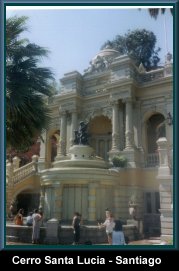 As far as work goes, it was pretty tough! These Chileans are
smart people and they asked a lot of intelligent questions that
really kept me on my toes. In comparison to other spanish-speaking
people of South America, the Chileans are pretty conservative.
They know how to have fun (like the night when Gonzalo took me
out to several bars/clubs/discos in Providencia, El
Bosque, and Las Condes), they are hardworking (long
hours at the office), and are very civilized. Americans often
think of South America as an "extension of Mexico".
This could not be farther from the truth. The people in Chile are
more European than any others that I have seen in South America,
a fact that is reflected in social attitudes, architecture and
everyday life (although I have heard that Argentina is even more
European). These people have class. I really enjoyed working with
Fernando, Gonzalo and Jorge at the office.
As far as work goes, it was pretty tough! These Chileans are
smart people and they asked a lot of intelligent questions that
really kept me on my toes. In comparison to other spanish-speaking
people of South America, the Chileans are pretty conservative.
They know how to have fun (like the night when Gonzalo took me
out to several bars/clubs/discos in Providencia, El
Bosque, and Las Condes), they are hardworking (long
hours at the office), and are very civilized. Americans often
think of South America as an "extension of Mexico".
This could not be farther from the truth. The people in Chile are
more European than any others that I have seen in South America,
a fact that is reflected in social attitudes, architecture and
everyday life (although I have heard that Argentina is even more
European). These people have class. I really enjoyed working with
Fernando, Gonzalo and Jorge at the office.
I could go on and on. Did I mention Chilean Wine? Some of the best
stuff in the world (if you don't believe me, ask your friendly
sommelier. If you don't know what a 'sommelier' or an
'administrateur de vin'
is, then shut up...you have no clue what makes a wine a good wine anyway).
Next time I go back (and there will be a next time), I want to visit
valparaíso on the coast, go hiking in the Patagonia region. Let's
not forget Rapa Nui (Easter Island)...it has been on my "to visit"
list since Geography class in the 6th grade. That's part of the
frustration in visiting Chile: The country is SO big and SO diverse,
that it is impossible to cover everything that you want to do in
one visit (unless that visit is for 6 months)!
Other Destinations
 Big
Sur, California Big
Sur, California |
 Lisbon,
Portugal Lisbon,
Portugal |
 Paris,
France Paris,
France |
 Madrid,
Spain Madrid,
Spain |
 São
Paulo, Brazil São
Paulo, Brazil |
 Caracas,
Venezuela Caracas,
Venezuela |
 Amsterdam,
Netherlands Amsterdam,
Netherlands |
 Arnhem,
Netherlands Arnhem,
Netherlands |
 Nassau,
Bahamas Nassau,
Bahamas |
 London,
England London,
England |
 Curaçao,
Netherland Antilles Curaçao,
Netherland Antilles |
 Santiago,
Chile Santiago,
Chile |
 Edinburgh,
Scotland Edinburgh,
Scotland |
 Vancouver,
British Columbia, Canada Vancouver,
British Columbia, Canada |
 Hyderabad,
India Hyderabad,
India |
 Rome
& Florence, Italy Rome
& Florence, Italy |
|
|
© 2003 - Todd L. Holsopple
All photographs and HTML content are protected by copyright and may not
be used without written permission from Todd L Holsopple. Please
feel free to link to these pages without permission.
|
Web site hosted by http://www.ipowerweb.com
 Well, well, well ... another place that I never thought I
would ever visit: Chile. Because I never thought I would travel
to Chile, I did what most Americans (well, lets be honest....what
most people do, American or not) do when considering other people
in the world: I ignored it. Perhaps that is a little harsh:
Instead, let's just say that I was indifferent to Chile, her
people, and her politics. Over the past few years, I have started
to learn what sheer folly this outlook on the world is. In this
day and age when a flight on the Concorde can get you from North
America to Europe in just a few short hours, and Boeing is
working on a 747 with the fuel capacity to make it from San
Francisco to Moscow,
Well, well, well ... another place that I never thought I
would ever visit: Chile. Because I never thought I would travel
to Chile, I did what most Americans (well, lets be honest....what
most people do, American or not) do when considering other people
in the world: I ignored it. Perhaps that is a little harsh:
Instead, let's just say that I was indifferent to Chile, her
people, and her politics. Over the past few years, I have started
to learn what sheer folly this outlook on the world is. In this
day and age when a flight on the Concorde can get you from North
America to Europe in just a few short hours, and Boeing is
working on a 747 with the fuel capacity to make it from San
Francisco to Moscow,  non-stop, it is foolish to ignore other
countries and cultures. Add to this the "coming of age"
of the World Wide Web, and it becomes even more important to know
more about your neighbors, because with the Net, everyone in the
world is your neighbor. With that being said, I encourage all of
you to ignore Chile...that way it will remain as beautiful as it
is today (and the next time I go back there won't be throngs of
tourists there who read this web page and decided to see it for
themselves).
non-stop, it is foolish to ignore other
countries and cultures. Add to this the "coming of age"
of the World Wide Web, and it becomes even more important to know
more about your neighbors, because with the Net, everyone in the
world is your neighbor. With that being said, I encourage all of
you to ignore Chile...that way it will remain as beautiful as it
is today (and the next time I go back there won't be throngs of
tourists there who read this web page and decided to see it for
themselves). My trip to Santiago in February felt
exactly like late September in Sacramento: pleasantly warm with
low humidity. A lot of the flora and fauna are quite similar too,
although Santiago has some indigenous plants as well. Don't let
this "similarity" to Central Northern California fool
you, however. Chile is a country that stretches nearly 4,300
kilometers (2,700 miles for the "metrically-challenged")
and encompasses drastic differences in geography: From the Atacama
Desert (a desert that has NEVER recorded rainfall) that lies
in the northern part of the country, to the vast rainforests of Patagonia
to the frigid lands of Antarctica....Chile has it all.
My trip to Santiago in February felt
exactly like late September in Sacramento: pleasantly warm with
low humidity. A lot of the flora and fauna are quite similar too,
although Santiago has some indigenous plants as well. Don't let
this "similarity" to Central Northern California fool
you, however. Chile is a country that stretches nearly 4,300
kilometers (2,700 miles for the "metrically-challenged")
and encompasses drastic differences in geography: From the Atacama
Desert (a desert that has NEVER recorded rainfall) that lies
in the northern part of the country, to the vast rainforests of Patagonia
to the frigid lands of Antarctica....Chile has it all. of Santiago on
the Eastern edge of town. There was a noticeable lack of "shanty
towns" which always seem to exist on the outskirts of major
South American cities, which testifies to the prosperity of the
Chileans. Indeed Chile is one of South America's most stable
countries, both politically (despite the Pinochet incident) and
economically. Comfortably ensconced in my hotel (the Regal
Pacific in Las Condes), I headed out to see the city.
Santiago actually has a useful (to us tourists) subway (Métro)
system. Other South American cities such as
of Santiago on
the Eastern edge of town. There was a noticeable lack of "shanty
towns" which always seem to exist on the outskirts of major
South American cities, which testifies to the prosperity of the
Chileans. Indeed Chile is one of South America's most stable
countries, both politically (despite the Pinochet incident) and
economically. Comfortably ensconced in my hotel (the Regal
Pacific in Las Condes), I headed out to see the city.
Santiago actually has a useful (to us tourists) subway (Métro)
system. Other South American cities such as  has it that all points in Chile are measured in kilometers from
this office. Kinda like Rome, isn't it?), the Catedral (no, that's
not a spelling mistake), the Palacio de la Real Audencia (Natural
History Museum), and enjoy a rousing game of chess and a lemonade
in the square (just watch out for the "dive bomber"
pigeons in the square). Head east out of Plaza de Armas
on Merced. On the corner of Merced and Mac-Iver
(a few blocks ) is the Basilica Merced a "church-turned-museum".
Unfortunately, this was closed the day I was there. According to
my guidebook (the "Open Road" Chile Guide), this place
has some of the best artifacts from Easter Island (owned by Chile).
There are several other museums in this area that deal with
colonial Chile and one in particular that my guidebook rather
colorfully referred to as "...and extensive tribute to
dandified white guys with guns..." (sorry, I just
couldn't resist putting that line up here on my page....it kills
me!). I stopped for lunch at a French place on Merced called 'Les
Assesins'. The Coquille San Jacques was fantastic,
and best of all, they understood my French (my Spanish is merely
passable). Wash your meal down with the Chilean "Pisco
Sour". Pisco is a type of brandy (this
originally comes from Peru, but don't tell that to the Chileans).
Mixed with lemon juice, powdered sugar and egg whites, it creates
the wonderfully refreshing Pisco Sour (don't have too
many, though...this ranks right up there with the Brazilian Caipirihnia
for "most punch per drink").
has it that all points in Chile are measured in kilometers from
this office. Kinda like Rome, isn't it?), the Catedral (no, that's
not a spelling mistake), the Palacio de la Real Audencia (Natural
History Museum), and enjoy a rousing game of chess and a lemonade
in the square (just watch out for the "dive bomber"
pigeons in the square). Head east out of Plaza de Armas
on Merced. On the corner of Merced and Mac-Iver
(a few blocks ) is the Basilica Merced a "church-turned-museum".
Unfortunately, this was closed the day I was there. According to
my guidebook (the "Open Road" Chile Guide), this place
has some of the best artifacts from Easter Island (owned by Chile).
There are several other museums in this area that deal with
colonial Chile and one in particular that my guidebook rather
colorfully referred to as "...and extensive tribute to
dandified white guys with guns..." (sorry, I just
couldn't resist putting that line up here on my page....it kills
me!). I stopped for lunch at a French place on Merced called 'Les
Assesins'. The Coquille San Jacques was fantastic,
and best of all, they understood my French (my Spanish is merely
passable). Wash your meal down with the Chilean "Pisco
Sour". Pisco is a type of brandy (this
originally comes from Peru, but don't tell that to the Chileans).
Mixed with lemon juice, powdered sugar and egg whites, it creates
the wonderfully refreshing Pisco Sour (don't have too
many, though...this ranks right up there with the Brazilian Caipirihnia
for "most punch per drink"). Continue heading East (as a
side note, there is a lot of Art Deco and Neoclassical
Architecture in this neighborhood....be sure to check it out)
until you reach the Cerro Santa Lucia. You can't miss
this thing...it's a huge mountain right in the middle of the city.
When entering, you will be asked to "sign in" with your
passport (apparently, there once was a lot of crime in this park,
and the City is doing this as a protective measure. I found it to
be quite safe during the day, but I wouldn't want to try this
place at night). This was my favorite place in all of Santiago.
At the top of the hill, there is a replica of a Medieval Castle,
and there are all sorts of plants, flowers, statues and fountains
all over this mountain and it provides fantastic views of the
city and the Andes. If you are fortunate enough to be travelling
with your "significant other", find a small secluded
place in the rocks and "make out" like crazy....it's
what the locals do. From the top of the mountain, you can also
see a neighboring hill called the Cerro San Cristobal
and the cable car that takes you to the top. On one side of the
mountain, you will see the Biblioteca Nacional. Head to
the right of this, and exit through the main entrance/exit to the
Cerro Santa Lucia and cross the Alameda (good
luck...there is an iron fence in the median and no crosswalks for
about a mile or so on either side. Go ahead....live dangerously)
to the Centro Artesanal de Santa Lucia. This place is
one of the best markets that I have seen. Pick up some Lapis
Lazuli jewelry or some Chilean CDs or (if you're loaded
with Chilean Pesos) splurge on some fantastic artwork.
Continue heading East (as a
side note, there is a lot of Art Deco and Neoclassical
Architecture in this neighborhood....be sure to check it out)
until you reach the Cerro Santa Lucia. You can't miss
this thing...it's a huge mountain right in the middle of the city.
When entering, you will be asked to "sign in" with your
passport (apparently, there once was a lot of crime in this park,
and the City is doing this as a protective measure. I found it to
be quite safe during the day, but I wouldn't want to try this
place at night). This was my favorite place in all of Santiago.
At the top of the hill, there is a replica of a Medieval Castle,
and there are all sorts of plants, flowers, statues and fountains
all over this mountain and it provides fantastic views of the
city and the Andes. If you are fortunate enough to be travelling
with your "significant other", find a small secluded
place in the rocks and "make out" like crazy....it's
what the locals do. From the top of the mountain, you can also
see a neighboring hill called the Cerro San Cristobal
and the cable car that takes you to the top. On one side of the
mountain, you will see the Biblioteca Nacional. Head to
the right of this, and exit through the main entrance/exit to the
Cerro Santa Lucia and cross the Alameda (good
luck...there is an iron fence in the median and no crosswalks for
about a mile or so on either side. Go ahead....live dangerously)
to the Centro Artesanal de Santa Lucia. This place is
one of the best markets that I have seen. Pick up some Lapis
Lazuli jewelry or some Chilean CDs or (if you're loaded
with Chilean Pesos) splurge on some fantastic artwork. I had the eerie sensation of witnessing a full lunar eclipse while I was in
Santiago. This was a little creepy. First of all, I was on the 11th
floor of the hotel. With the Andes as a spectacular backdrop, I
watched while the moon slowly disappeared from view over several
hours. One tip if staying at the Regal Pacific: try to get a room
on one of the upper floors with a North facing view. I was very
eager to get up in the morning, because my bathroom faced East,
and I was able to watch the sun rise (the bathroom had a HUGE
window) over a 5,200 meter peak (once again, about 17,000 feet
for the "metrically-challenged")...awesome! I
definitely need to get back here during the Austral Winter (North
American summer) to check out the legendary ski resorts like Valle
Nevado and Colorado-Farellones. The road that heads
up to the resorts starts in Las Condes, and is reported
to be a nightmare of hairpin turns and switchbacks. My buddy
Gonzalo, who I was there to work with, also loves to ski and said
that the skiing is fantastic (as if Warren Miller Movies were not
enough inspiration). The Andes simply take your breath away...they
dwarf the Rocky Mountains in height and are incredibly "awe-inspiring".
I had the eerie sensation of witnessing a full lunar eclipse while I was in
Santiago. This was a little creepy. First of all, I was on the 11th
floor of the hotel. With the Andes as a spectacular backdrop, I
watched while the moon slowly disappeared from view over several
hours. One tip if staying at the Regal Pacific: try to get a room
on one of the upper floors with a North facing view. I was very
eager to get up in the morning, because my bathroom faced East,
and I was able to watch the sun rise (the bathroom had a HUGE
window) over a 5,200 meter peak (once again, about 17,000 feet
for the "metrically-challenged")...awesome! I
definitely need to get back here during the Austral Winter (North
American summer) to check out the legendary ski resorts like Valle
Nevado and Colorado-Farellones. The road that heads
up to the resorts starts in Las Condes, and is reported
to be a nightmare of hairpin turns and switchbacks. My buddy
Gonzalo, who I was there to work with, also loves to ski and said
that the skiing is fantastic (as if Warren Miller Movies were not
enough inspiration). The Andes simply take your breath away...they
dwarf the Rocky Mountains in height and are incredibly "awe-inspiring".
 As far as work goes, it was pretty tough! These Chileans are
smart people and they asked a lot of intelligent questions that
really kept me on my toes. In comparison to other spanish-speaking
people of South America, the Chileans are pretty conservative.
They know how to have fun (like the night when Gonzalo took me
out to several bars/clubs/discos in Providencia, El
Bosque, and Las Condes), they are hardworking (long
hours at the office), and are very civilized. Americans often
think of South America as an "extension of Mexico".
This could not be farther from the truth. The people in Chile are
more European than any others that I have seen in South America,
a fact that is reflected in social attitudes, architecture and
everyday life (although I have heard that Argentina is even more
European). These people have class. I really enjoyed working with
Fernando, Gonzalo and Jorge at the office.
As far as work goes, it was pretty tough! These Chileans are
smart people and they asked a lot of intelligent questions that
really kept me on my toes. In comparison to other spanish-speaking
people of South America, the Chileans are pretty conservative.
They know how to have fun (like the night when Gonzalo took me
out to several bars/clubs/discos in Providencia, El
Bosque, and Las Condes), they are hardworking (long
hours at the office), and are very civilized. Americans often
think of South America as an "extension of Mexico".
This could not be farther from the truth. The people in Chile are
more European than any others that I have seen in South America,
a fact that is reflected in social attitudes, architecture and
everyday life (although I have heard that Argentina is even more
European). These people have class. I really enjoyed working with
Fernando, Gonzalo and Jorge at the office. 












